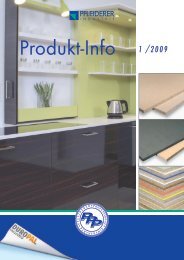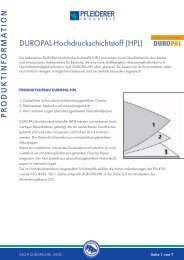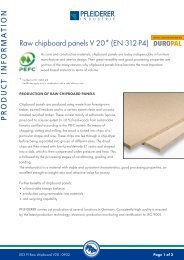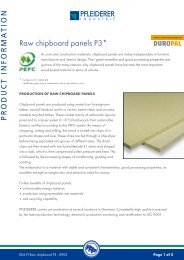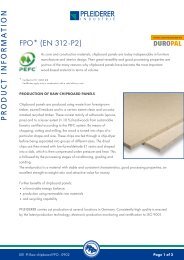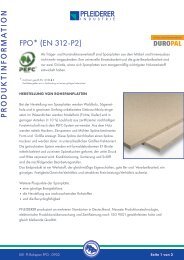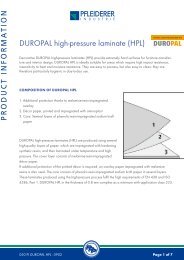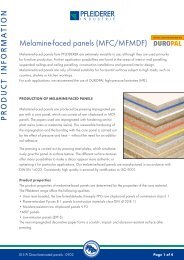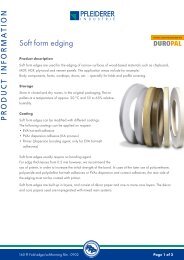Processing and working instructions HPL and HPL elements PR ...
Processing and working instructions HPL and HPL elements PR ...
Processing and working instructions HPL and HPL elements PR ...
Create successful ePaper yourself
Turn your PDF publications into a flip-book with our unique Google optimized e-Paper software.
<strong>PR</strong>ODUCT INFORMATION<br />
The application of the individual adhesives is explained below:<br />
a) Dispersion adhesives<br />
These include PVAc adhesives <strong>and</strong> 2-component PVAc dispersion adhesives. Apply the adhesive with a<br />
toothed spreader or h<strong>and</strong> roller. This can also be done with adhesive application machines or four-roller<br />
machines. Cold pressing is carried out using screw clamps, spindle presses or single-/multi-daylight presses,<br />
<strong>and</strong> warm pressing with single- or multi-daylight presses, short cycle presses, roller presses or double-belt<br />
presses. Take care to observe the pressing times/temperatures accurately with sparing <strong>and</strong> even adhesive<br />
application.<br />
b) Condensation resin adhesives<br />
These include urea resin, melamine-urea resin, phenolic resin <strong>and</strong> resorcinol resin. Phenolic- <strong>and</strong> resorcinol<br />
resin are used principally for DUROPAL <strong>HPL</strong> <strong>elements</strong> which require high resistance to exposure to flames.<br />
Condensation resin adhesives require corresponding additives in order to make the adhesive joint elastic.<br />
The guideline values can vary according to the hardener type. Impurities consisting of remains of adhesive<br />
or hardener cannot be removed from the DUROPAL <strong>HPL</strong> surface after bonding without damaging the material.<br />
Ensure therefore that these are completely removed before bonding. For cold <strong>and</strong> warm pressing, the<br />
same tool specifications apply as for dispersion adhesives.<br />
c) Contact adhesives<br />
Without hardener: When applying with a toothed spreader, the application direction on the core material<br />
<strong>and</strong> laminate should be at right-angles to one another. The adhesive can also be applied with a brush,<br />
or by spraying <strong>and</strong> pouring systems. In all cases, great care <strong>and</strong> good ventilation must be ensured when<br />
<strong>working</strong>. Contact adhesives require a short, powerful contact pressure. The open time can be reduced by<br />
accelerated drying of the adhesive films, although over-drying should be avoided. Dried-on adhesive films<br />
can be reactivated by heat, e.g. infrared radiation.<br />
The pressing procedure is carried out as described.<br />
With hardener: This adhesive enables higher stress <strong>and</strong> temperature resistance of the joint. For further<br />
information, please consult the manufacturer.<br />
d) Mixed adhesives<br />
General <strong>working</strong> recommendations cannot be given here, since this category is divided into different types<br />
<strong>and</strong> used only for special bonding.<br />
e) Hot-melt adhesives<br />
These are used principally for edge bonding.<br />
099 PI <strong>Processing</strong> <strong>and</strong> <strong>working</strong> <strong>instructions</strong> Page 22 of 34



